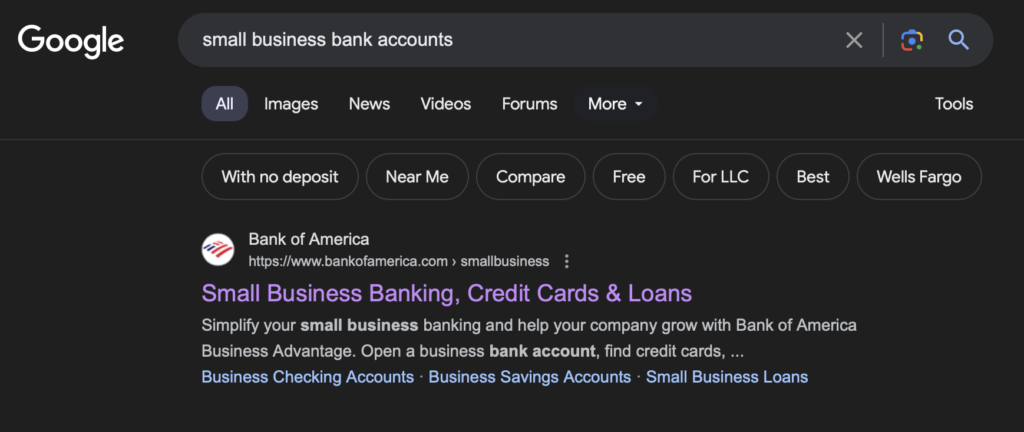The advancement of search technology and the growing role alternative content formats like video play in buying journeys has meant that text-based meta data has lost some of the luster it once held. Nevertheless, website meta data is regularly used by search engines to understand content and they may even use it when displaying a given webpage in search results. Google has formally stated that it uses meta data to create snippets that give users a sense of what a webpage is about. Google more specifically says “Google sometimes uses the meta description HTML element if it might give users a more accurate description of the page than content taken directly from the page.”
Given the possibility that meta data could be displayed to potential customers, it’s important to include it in any optimization effort. This possibility is enhanced when the meta data may give users a more accurate sense of the page’s content.
Where Meta Data Might Be Displayed
Let’s start by looking at where you might encounter meta data, specifically descriptions. When I search for small business bank accounts, I get millions of results. At the top of the list is none other than Bank of America, the United States’ second largest bank.

I can see from the search results page that there is quite bit of text for each result. In the case of Bank of America I see a message about simplifying small business banking. If I navigate to the source code of this page, I’ll see that same message defined in the meta data.

The one draw back to the text Bank of America provides is that it is cut off by the search engine in results. This is because they exceeded the recommended 155 character threshold. If I were advising the digital marketing team at BoA, I would encourage them to edit this meta data down to less than 155 characters so that it doesn’t get cut off.
How to Optimize Meta Data Using Google Search Console
Google Search Console is a free tool that helps website owners manage the appearance of their sites in Google Search. While there’s a lot to unpack in any discussion of GSC, the important thing to note here is that it provides robust reporting on the number of impressions and clicks a given webpage receives, along with the average position it displays in on a search results page (SERP). Click-through rate (CTR, the ratio of clicks to impressions) is a critical metric in understanding the efficacy of a result. Typically speaking, the higher a CTR is, the more relevant and effective the text was in compelling someone to click.
For those seeking to improve their site’s performance, I recommend first examine the average CTR across your website and using it as a benchmark. In the example below, you can see the GSC performance report which details the KPIs of a site during a given period of time.

Aside from the influence of a few outliers, most of your pages will be evenly distributed above or below that CTR baseline. Given that there may be a ceiling to how much you can improve a page’s CTR, we want to focus on the pages that have CTRs lower than the site average. These should be our priority of optimization.
I can use GSC to produce a list of these pages by filtering the results have a CTR below my site average. To do this, I’ll deselect clicks and impressions and select Average CTR. Then I’ll filter the list of pages to ones that are below my average CTR. I can save this list so that I can reference it as I begin to re-write or optimize my meta data. I may find that the pages with lower CTRs either do not have meta data specified (thus allowing Google to choose whatever it wants) or the text is bland and boring.

Writing New Meta Data
When I’m writing new meta descriptions or providing other details, I want to be sure to put myself in the shoes of the target audience. Based on the keywords someone is likely searching, I should ask myself: If I saw this text, would it make me want to click? More than likely there are some word changes I can make to encourage a user to take action. For example, let’s take this example I saw while shopping for cupsole skate shoes:

As you can see the SERP snippet has a description that fails to say anything interesting or compelling about the products. Rather than displaying a site owner-specified description, Google has pulled from the site’s menu instead.
If we look at the source code of this webpage, we’ll see that the meta data is very generic and not directly related to cupsole skate shoes at all. If I were the website owner, I would want to spend time optimizing this section to A) be more compelling to searchers like me and B) more closely relate to the products displayed on the page. For example I could say: “CCS has the best selection of cupsole skate shoe at the best prices. Shop by brand, size, color and more for shoes that keep your feet feeling great!” If I do that, I would expect the page’s CTR to increase.

Conclusion
Hopefully you’re able to see that using GSC to optimize meta data is not only useful, it’s incredibly easy. Surprisingly, many website owners miss this key opportunity to reach new customers and drive greater performance. Don’t be one of them that misses out!
If you’re looking for help optimizing your website to attract and develop new customer relationships, Riviea can help. Get in touch with us today!

0 Comments